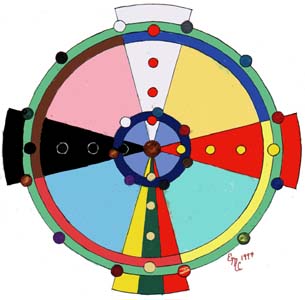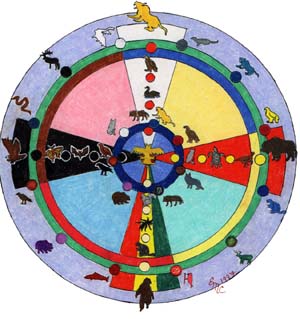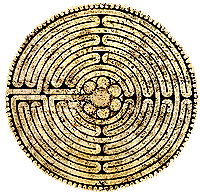Native American Medicine Wheel
~ | ~ Sacred Altar
~ | ~ East ~ | ~ South
~ | ~ West ~ | ~ North ~ | ~
 As I began to dig deeper into other belief systems and made more connections, I found that the original design needed some refining. And just as Jesus is known as the Refiner of Gold, I reworked the Medicine Wheel design to support the application of new ideas (rather these are really old ideas). I balanced the design to fit each stone in its respective place. The seven stones in the inner ring are equidistant from each other, the twelve stones in the outer ring are also equidistant, and the four stones on each directional arm as well. While the original 16-spoke design is accepteable, I believe this design to be more accurate.
As I began to dig deeper into other belief systems and made more connections, I found that the original design needed some refining. And just as Jesus is known as the Refiner of Gold, I reworked the Medicine Wheel design to support the application of new ideas (rather these are really old ideas). I balanced the design to fit each stone in its respective place. The seven stones in the inner ring are equidistant from each other, the twelve stones in the outer ring are also equidistant, and the four stones on each directional arm as well. While the original 16-spoke design is accepteable, I believe this design to be more accurate.
After laying out the basic design, I was able to add the animals and other elements to show relationships between each system. By doing so, I am also able to quickly share how each set of elements fits with the Medicine Wheel.
- East
- The direction where the sun rises, is represented by red or yellow. Red for the redness of the sun as it rises above the horizon, or yellow for the early morning. It is also the season of Spring when living things begin a new cycle: plants spring forth with new buds and flowers, many animals begin their mating cycles, birds sing to announce the arrival of longer days and the coming warmth. It is the birth of the new person.
- South
- The direction the sun is at noon, and at it's highest point in the sky. It is the hottest part of the day, and it is Summer. The colors of white, red, yellow or green are used here. Red is for the heat of the summer sun, yellow for the sun's brightness, green for growing. White is for the sun's zenith: the sun is highest in the sky and brightest at its zenith, and it is the time when one can see farthest. Plants are in full growth and fruit is ripening for the harvest. Animals browse on the lush green plants, and birds feed on the bugs, nectar, and small vermin which have taken up residence in the lush summer growth.
- West
- The direction the sun sets, from whence the Thunder Beings and rains come. Darkness is represented in the black. It is a time to store up for the winter, and prepare for the storms from the North. It represents Autumn, as well as Death and Resurrection. I have used ingido blue in many of my representations to indicate darkness and still allow the black stones to be visible on its path. The direction of water and rain, blue is still appropriate here - the deeper the water, the darker it gets
- North
- The sun is on the other side of the earth at this time. In ancient belief systems, the sun "died" when it set on the western horizon, and was "reborn" again in the East as it rose. The storms of winter come from the North, represented by white in the Medicine Wheel for the snow that blankets the earth. Red is also shown for it represent the blood-strength it takes to survive the storms of winter. It is a time for survival, a time for introspection, and preparation for the renewal in spring.

- Center
- In the center is the Creator, Wankan-Tanka, Tyee Saghali, Great Chief of the Above. This represents the spiritual realm, where all points on the circle meet when looking inward. A straight and narrow path? More like a pointed path! Without direct focus on the center of the wheel, all else is anything but a straight path to Creator! The color here is the color of the clouds - or a celestial blue.
- Inner Circle
- The seven stones, representing the seven spirit-messengers of God are seated in the heavenly realm. This is the inner circle of blue on the wheel.
- Outer Circle
- The twelve stones around the outside of the Medicine Wheel are representative of twelve moons of the year. These twelve moons also relate to the twelve Apostles, and also to the twelve elders of Israel (as you will see elsewhere). This is represented by the green circle in the Wheel.
- Seasons
- The seasons are represented by the four-colored ring just inside the outer circle. Yellow for spring, red for summer, brown for autumn, and blue for winter. These colors are derived from The Coloring Song.
- Life Cycles
- The life cycles are represented in the wheel as quadrants between the directions. The first quadrant here is Northeast and represents the time of life from birth through 12 years of age*, and the color is yellow for innocence. The second quadrant (Southeast) is green for growing and learning, and represents the time of youth - 12 through 24 years of age. The third quadrant is blue and represents the time of adulthood and parenthood. The stage of life is 24 through 36 years of age, and its opposition to the youngest stage in the wheel is appropriate since, it is the adults who rear the young and to whom the young look up to for guidance. The fourth quadrant is pink and represents the "elder" stage of life, from 36 years and older. It is the elders who teach the youths the legends of their people (regardless of culture), and it is the elders who are the leaders. (* Ages are for reference only and may vary from culture to culture and between individuals.)
This two-dimensional representation fails to show how the Wheel may be seen in the third-dimension. Much as the earth is a globe spinning in space, the Medicine Wheel is really a symbolic globe. It has many connections with nature, with spirit, and with human principles.
Introduction: Page One
~ | ~ Page Two
~ | ~ Page Three
~ | ~ Page Four
~ | ~ Page Five ~ | ~
~ | ~ Sacred Altar
~ | ~ East
~ | ~ South
~ | ~ West
~ | ~ North ~ | ~
Inner Circle:
Owl ~ | ~ Cougar
~ | ~ Hawk ~ | ~ Coyote
~ | ~ Wolf ~ | ~ Bear
~ | ~ Raven ~ | ~
Outer Circle:
Snow Goose ~ | ~
Otter ~ | ~
Cougar ~ | ~
Hawk ~ | ~
Beaver ~ | ~
Deer ~ | ~
~ | ~ Flicker ~ | ~
Sturgeon ~ | ~
Bear ~ | ~
Raven ~ | ~
Snake ~ | ~
Elk ~ | ~
Blue ~ | ~
 As I began to dig deeper into other belief systems and made more connections, I found that the original design needed some refining. And just as Jesus is known as the Refiner of Gold, I reworked the Medicine Wheel design to support the application of new ideas (rather these are really old ideas). I balanced the design to fit each stone in its respective place. The seven stones in the inner ring are equidistant from each other, the twelve stones in the outer ring are also equidistant, and the four stones on each directional arm as well. While the original 16-spoke design is accepteable, I believe this design to be more accurate.
As I began to dig deeper into other belief systems and made more connections, I found that the original design needed some refining. And just as Jesus is known as the Refiner of Gold, I reworked the Medicine Wheel design to support the application of new ideas (rather these are really old ideas). I balanced the design to fit each stone in its respective place. The seven stones in the inner ring are equidistant from each other, the twelve stones in the outer ring are also equidistant, and the four stones on each directional arm as well. While the original 16-spoke design is accepteable, I believe this design to be more accurate.






